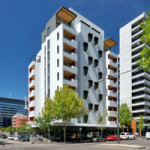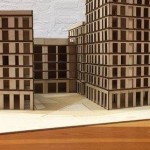In Australia, in Canada, in Europe, architects, developers and builders are doing more than just talk about the attributes of wood construction.
Forté – Australia’s first timber high rise apartment building was completed in 2012 and stands at 32.17 meters tall. The Melbourne boutique apartment complex, made entirely from wood, “is a sustainable, eco-friendly residential tower that blends modern architecture with a natural building material, Cross Laminated Timber (CLT). CLT improves efficiencies, safety and speed in construction, is 30 percent more efficient to use, and has a far lower carbon footprint than other building materials.” The use of CLT will reduce CO2 equivalent emissions by more than 1,400 tons – the same as taking 345 cars off the road.
To learn more, visit www.forteliving.com.au
Wood Innovation Design Centre – Located in British Columbia and “conceived to showcase the potential for building mid- and high-rise structures using engineered mass timber products, the Centre’s design incorporates a simple, ‘dry’ structure of systems-integrated CLT floor panels, Glulam columns and beams, and mass timber walls. The building’s structural simplicity is easily replicated, a fundamental choice made in the interest of seeing many more architects, engineers, and private developers recognize the value of mass timber design as alternative to steel and concrete.” No concrete was used above the ground floor slab. The eight-story building stands 97 feet tall.
Visit mg-architecture.ca to learn more.
Dalston Lane – Now under construction in London, Dalston Lane is a 10-story, 121-unit apartment complex slated to become the tallest structure of its kind in the UK. It is estimated that more than 3,000m3 of timber will be used on this record-breaking, cross-laminated timber (CLT) structure, making it, by volume, the largest CLT project globally. For its developer and CLT engineering group, “the most exciting aspect of the project is the sheer size of the structure and its completion without the use of thousands of cubic metres of concrete.”
In addition to sequestering carbon in its mass amount of wood, it is calculated that the building’s CLT construction will save 2,400 tons of carbon, making the structure “carbon negative.”
Visit www.waughthistleton.com to learn more.





